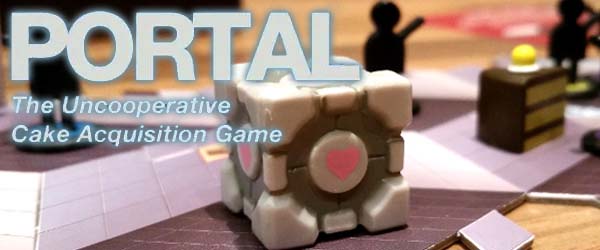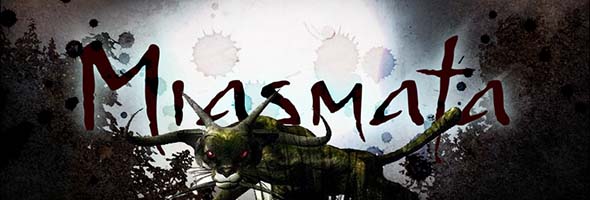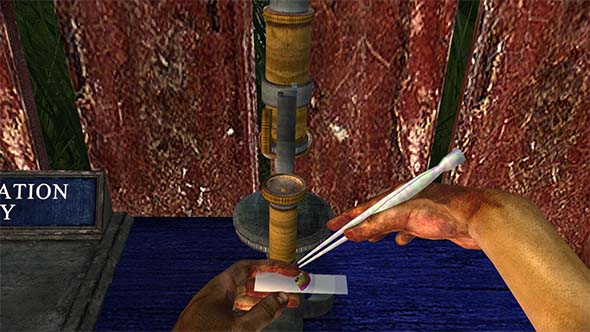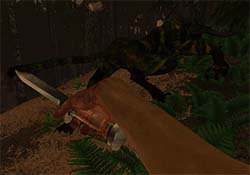
Portal is one of the best and most successful video games ever made. In the current climate of table top board game manufacturers trying to license every property that they can possibly get a hold of, I guess it only makes sense that there would have been a board game based on the Portal video game. But what could a board game designer possibly do with the physics and gravity-bending environmental puzzle-solving concepts of the 2 Portal video games? Cryptozoic's answer was to not even really try. While they did manage to come up with a unique and novel board game design, it's a design that I don't feel really does justice to the title's namesake.
You will be tested, and then there will be cake
Portal: The Uncooperative Cake-Acquisition Game is based around a modular, evolving board concept. 15 tiles are placed on the table in three rows of 5. At the end of each player's turn, one tile is removed from the right edge of the board (the "Old Edge"), flipped over, and moved to the left edge of the board (the "New Edge"). If a player controls a majority of the test subject pieces in the removed tile, he or she is given a set of rewards printed on the tile. This may include being able to place additional test subjects in order to establish more control over the board, being able to place or move a turret or Companion Cube figurine, or placing a victory point token on the board (which takes the form of a plastic slice of cake).
Any player piece(s) on the removed tile are also destroyed. Test subjects are returned to the respective player's supply, but any cake slices (which are victory points) are placed in the "Incinerator", and are removed from the game permanently. The objective of the game, thus, is to place as much cake on the board as you can, while also trying to keep that cake away from the old edge of the board so that it does not become incinerated. What makes this a somewhat challenging puzzle to solve is that the conveyor belt nature of the board is constantly pushing everything towards incineration.
Tiles move from one end of the board to the other, like a conveyor belt.
Each players' test subject tokens can pick up a piece of cake (belonging to any player) and carry the cake with it when the test subject moves. This is how players protect their own cake from the incinerator, but it also allows other players to pick up a rival's cake and move it closer to being incinerated. Thus, the competitive and subversive element is introduced. Players must try to maximize their own resources, while simultaneously trying to minimize their opponents' resources.
Oh, and there's also a couple of portal tokens which allow test subjects to move long distances across the board (and potentially take cake with them). And there's also a GladOS cardboard cutout, which does absolutely nothing except to mark which test chamber tile is being incinerated and recycled. The actual portals in the game's namesake, and the primary villain of the games, thus feel under-utilized. The portals just provide an extra opportunity for long-distance movement, but the game is completely playable without including them at all. They aren't even remotely necessary -- let alone fundamental -- to the board game's design, the way they are in the video game.
Turret and Companion Cube are nice 3-D plastic models,
but GladOS is just a cardboard cutout.
It's also a shame that the GladOS token is not a 3-D plastic model. The turret and Companion Cube are both plastic models and look really nice, so it's a shame that GladOS didn't get the same treatment. If she had, I could easily see this game's pieces becoming part of a nice little display diorama on a shelf somewhere when they are not in use for actual play.
In general, the board game lacks the spatial puzzle-solving element of the video game. The board is constantly in flux, and so a large focus of the game is on manipulating the physical space of the game board, and there is a certain degree of spatial-puzzle-solving present. But from my experience, most of that manipulation feels pretty rote and predictable. While there are certainly the occasional opportunities for really creative plays (especially when ability cards are used to modify various game rules or give the player extra powerful actions), the bulk of the game is pretty straight-forward.
[More]
4d8c2ed3-71aa-4dfa-8725-7de9aa00df1f|0|.0
Tags:Portal, Portal: The Uncooperative Cake Acquisition Game, Portal 2, Cryptozoic, Valve, Steam, GladOS, Cave Johnson, Chell, laboratory, test chamber, cake, turret, Companion Cube, Matt Hyra

Although not a terrific game, the indie survival adventure game Miasmata (developed by Bob and Joe Johnson of IonFX) is an interesting title that does deserve to be played by its target audience. It's not a particularly challenging game, but players can back themselves up into seemingly insurmountable holes. Knowing the game's mechanics and rules - and knowing them early - is important to ensuring that you aren't forced to restart from the beginning or give up entirely.
Like with my previous strategy post for Alien Isolation, I am not going to provide specific walkthroughs for the game or any of its specific set piece challenges. In fact, doing so would be even harder than in Alien because Miasmata is a completely open-ended sandbox game. Instead, I will be offering some general-purpose tips that should be relevant for the entire game. This will include some techniques for working around the game's bugs and odd design flaws.
Owl statues point towards a cache of medicinal plants, but they do not count as landmarks or show up on the map.
This should be a pretty obvious tip. If you find the plants that are used for the 3 parts of the cure, or the three emphasis drugs, you should immediately pick them and ... [More]
12a74aef-1703-47e6-97c5-527408d0f4fe|1|5.0
Tags:Miasmata, IonFX, Bob Johnson, Joe Johnson, Steam, indie gaming, survival, action, adventure, horror, island, science, laboratory, specimen, sample, chemistry, map, compass, cartography, triangulation, torch, night, hallucination

While looking for new survival horror games on Steam, I stumbled onto a very intriguing title: Miasmata. During my holiday break from work, I decided to boot up the game and see if it scratched my survival horror itch.
It didn't, on account of not actually being a survival horror game. But what I found instead was an equally interesting premise that immediately caught my attention and piqued my curiosity.
The Johnson brothers kept this game about as simple as it could possibly be (perhaps to its detriment). They had a core concept, and they stuck to it. As such, Miasmata is a very novel game. It is probably the only game that I've ever played that is solely about scientific research.
The end goal is to cure a disease that the character has contracted and then escape the island. This disease acts as the central challenge to the game: you have to periodically medicate yourself in order to control the symptoms, but all medications must be derived from the local flora. Failure to do so can slow you down, blur your vision, and eventually kill you. A sheer majority of the game, thus, consists of wandering around the island collecting samples of plants, and then returning them to the nearest laboratory to examine them and use them to concoct various potions. In addition to medicines, you can also create potions to enhance your physical strength and perception. Doing so will allow you to run and swim further, and allow you to always know your location on the map (respectively).

Stand back! I'm about to do SCIENCE!
Unfortunately, the process of analyzing the specimens is automated (via a skip-able cutscene). You don't actually have to do anything in order to figure out what the plant's effects are going to be, and no actual scientific knowledge is required by the player. Each plant also only has one effect, so the potion-making mechanic (which is the core of the game) is pretty shallow.
The effects of each plant will be noted in your journal, which is one of the best journal features of any game that I've ever played. It has a handy status page that includes pockets for storing your medicines, as well as holding your water flask. It also shows your objectives and has tabs to collected notes, your research results, and the map. The journal is also populated with hyperlinks that take you to the journal page with the relevant information. For example, if you find a note with ingredients for an objective drug, the status page will add a hyperlink to that note underneath the objective. It's every bit the journal that Silent Hill: Downpour wanted to have!
As you explore, you'll also find camps left behind by the deceased research team. These camps can contain notes that can reveal bits of backstory, provide recipes for various potions, or point you in the direction of key plant specimens. The camps also act as safe places for you to restock your supplies (including water), rest, and save your progress.
Keeping yourself hydrated and rested is important, as failure to do so can aggravate the symptoms of your illness and potentially kill you. Unfortunately, the feedback for this isn't terribly great. You'll get a notification when you're thirsty, but the game doesn't bother to tell you that you're tired. Instead, your health just starts rapidly deteriorating for no apparent reason. It took me a while to figure out that it was due to a lack of sleep.

Combat mechanics are present,
but they don't have any affect.
A curious omission is that you don't have to eat. The game even includes various weapons scattered around the island, and there is an attack and throw command. But you can't attack the hostile panther-like creature that occasionally appears to hunt you, nor can you hunt and kill any of the game's various wildlife (beetles, squirrels, birds, and so forth). So you can only run and hide from the creature, and you only collect plants, which don't need to be attacked in order for specimens to be collected. So why are the weapons and attack mechanic even in the game?
Probably the second most significant mechanic is the map triangulation feature. Instead of revealing the map passively as you walk through it, the player must actively identify the location of landmarks ... [More]
d991856a-87f2-4dc9-8a5d-e20c1a004113|0|.0
Tags:Miasmata, IonFX, Bob Johnson, Joe Johnson, Steam, indie gaming, survival, action, adventure, horror, island, science, laboratory, specimen, sample, chemistry, map, compass, cartography, triangulation
|

| 12 | | | | | | | 60 | | 11 | | | | | | | 55 | | 10 | | | | | | | 50 | | 09 | | | | | | | 45 | | 08 | | | | | | | 40 | | 07 | | | | | | | 35 | | 06 | | | | | | | 30 | | 05 | | | | | | | 25 | | 04 | | | | | | | 20 | | 03 | | | | | | | 15 | | 02 | | | | | | | 10 | | 01 | | | | | | | 05 |
|